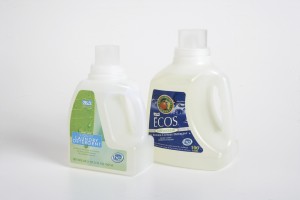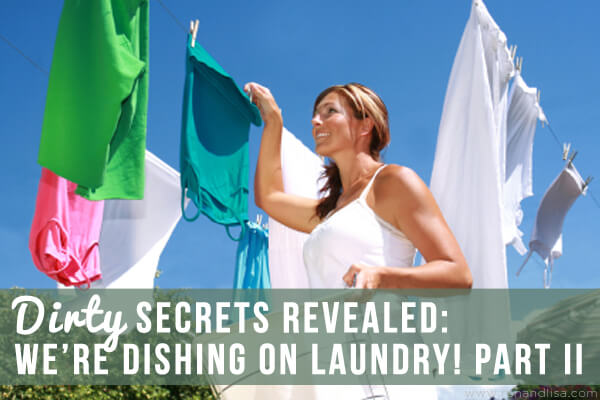Did the dirty gossip get you hooked? If so, then you’ll be pleased to know in Dirty Secrets Revealed: We’re Dishing on Laundry! Part I, we didn’t reveal all of the secrets. There’s one more… and it’s juicy!
Thanks to a gentleman by the name of David Steinman from the Green Patriot Working Group (GPWG) along with the Organic Consumers Association (OCA) , this dynamic duo began a study in 2007 to discover which consumer products were the worst offenders when it came to laundry detergent products containing 1,4-dioxane; a synthetic petrochemical carcinogen, found in many consumer products. Before you rush to grab your favorite laundry product to read the label, you might want to know that it won’t do you any good in this case. Why? 1,4-dioxane isn’t required to be listed on the ingredients label because it is a byproduct of the manufacturing process and is technically considered to be a contaminant. Nice loophole – for industry abusers – not you!
The 2010 results were shocking and 1,4-dioxane was found in most leading brands of laundry detergents tested. Here is the list of how the conventional and natural brands stacked up. *ppm = parts per million. *ND = non-detectable
Conventional brands:
- Tide (P&G) – 55 ppm
- Ivory Snow Gentle (P&G) – 31 ppm
- Tide Free (P&G) – 29 ppm
- Purex (Dial Corp.) – 25 ppm
- Gain 2X Ultra (P&G) – 21 ppm
- Cheer BrightClean Detergent (P&G) – 20 ppm
- Era 2X Ultra (P&G) – 14 ppm
- Arm & Hammer (Church & Dwight Co.) – 5.0 ppm
- Wisk 2X Ultra (Sun Products Corp.) – 3.9 ppm
- Woolite Complete Detergent (Reckitt Benckiser) – 1.3 ppm
- All laundry detergent (Unilever) – 0.6 ppm
- Dreft powdered detergent (P&G) – (ND)
- Sun Burst (Sun Products Corp.) – ND
“Natural” brands:
- Planet Ultra Liquid laundry detergent – 6.1 ppm
- Mrs. Meyers laundry detergent – 1.5 ppm
- Clorox Green Works Natural laundry detergent – ND
- Ecos laundry detergent (Earth Friendly Products) ND
- Life Tree Laundry Liquid – ND
- Method Squeaky Green laundry detergent – ND
- Seventh Generation Free & Clear laundry detergent – ND

- Petroleum distillates (napthas) – linked to cancer, lung damage and inflammation (asthma) and damage to mucous membranes
- Phenols – linked with damage to nervous system, heart, blood vessels, lungs (asthma) and kidneys
- Optical brighteners – toxic to fish and can cause allergic reactions.
So what’s a dirty guy or gal to do? Obviously, make sure you are doing your research or relying on the Healthy Home Dream Team and Just GREEN It! as a resource. You can also view and print out the Personal Care & Cleaning Products Safety Guide provided by the OCA HERE. If you are on a budget, you can always make your own and rest assured you will know exactly what you are exposing yourself and your family to.
Here are a few of my favorite do-it-yourself recipes that I use and swear by:
- Make your laundry brighter and whiter by adding these ingredients to your washing load:
1⁄4 cup of borax or 1⁄2 cup of washing soda. - Or, add 1⁄4 cup lemon juice in the rinse cycle for a bleach alternative.
- For an easy nontoxic fabric softener, add 1⁄4 cup of white vinegar to the rinse cycle.
But, the dirt isn’t just happening in the washer! Dryer sheets are often heavy on the fragrance, which means they don’t have to list any number of known toxins on their label. Look instead for wool dryer balls; not to be confused with plastic dryer balls. They not only soften your fabric, but they can reduce your drying time because they separate the clothes as they circulate. Another safe alternative is called Static Eliminator. It’s chemical-free, odor-free, reusable cloth that goes right into your dryer eliminates static, softens fabric and reduces wrinkles. It can be used over 500 times!
Finally, try hanging your clothes! I don’t know about your grandma, but mine always had the freshest, best smelling sheets and the whitest whites from hang drying! What’s more, it will make a huge impact on your energy bill (Nana’s true motivator I am sure). Did you know that the dryer is the 2nd biggest energy sucker in your home according the California Energy Commission? Dryers cost about $85 annually to run. By making the switch to line drying your clothes, you can save $40 a year; even if you hang just half of your laundry!
|




As always, you guys are helping us live healthier lives… Tried to find online if Ecover laundry contains 1,4-dioxane. I found their dish washing liquid does and they defend it on Treehugger. But couldn’t locate if in the laundry detergent. That said, I didn’t realize they’re a Belgium based co. That’s a big footprint that I’ll now avoid contributing!
Hi Bonnie!
Thanks for dropping by and for sharing your valuable input and comments regarding 1,4-dioxane. Yes, we too, found 1,4-dioxane detected in Ecover’s dishwashing liquid by independent, 3rd party testing. You can print out the entire list: RESULTS OF TESTING FOR 1,4-DIOXANE TESTING PERFORMED 2007-2010 HERE. It’s nice to keep this on hand as it shows test results for body care, laundry, etc. Hopefully, some of these manufacturers have plans to reformulate their prodcuts thanks to the OCA’s Coming Clean campaign. I did not find Ecover’s laundry detergent to contain 1,4-dioxane via the research provided. However, Earth Friendly’s Ecos brand was tested by independent testing and passed with flying colors in both their laundry and dishmate products; bonus that they are US based 🙂
Here is a bit more information from Green Patriot on how 1,4-dioxane ends up in these products in the first place. ‘1,4-dioxane is generated as a byproduct of ethoxylation, a process used by some companies to provide mildness to harsh cleaning ingredients, which requires use of the cancer-causing petrochemical ethylene oxide.’
Thanks and keep up the great work!